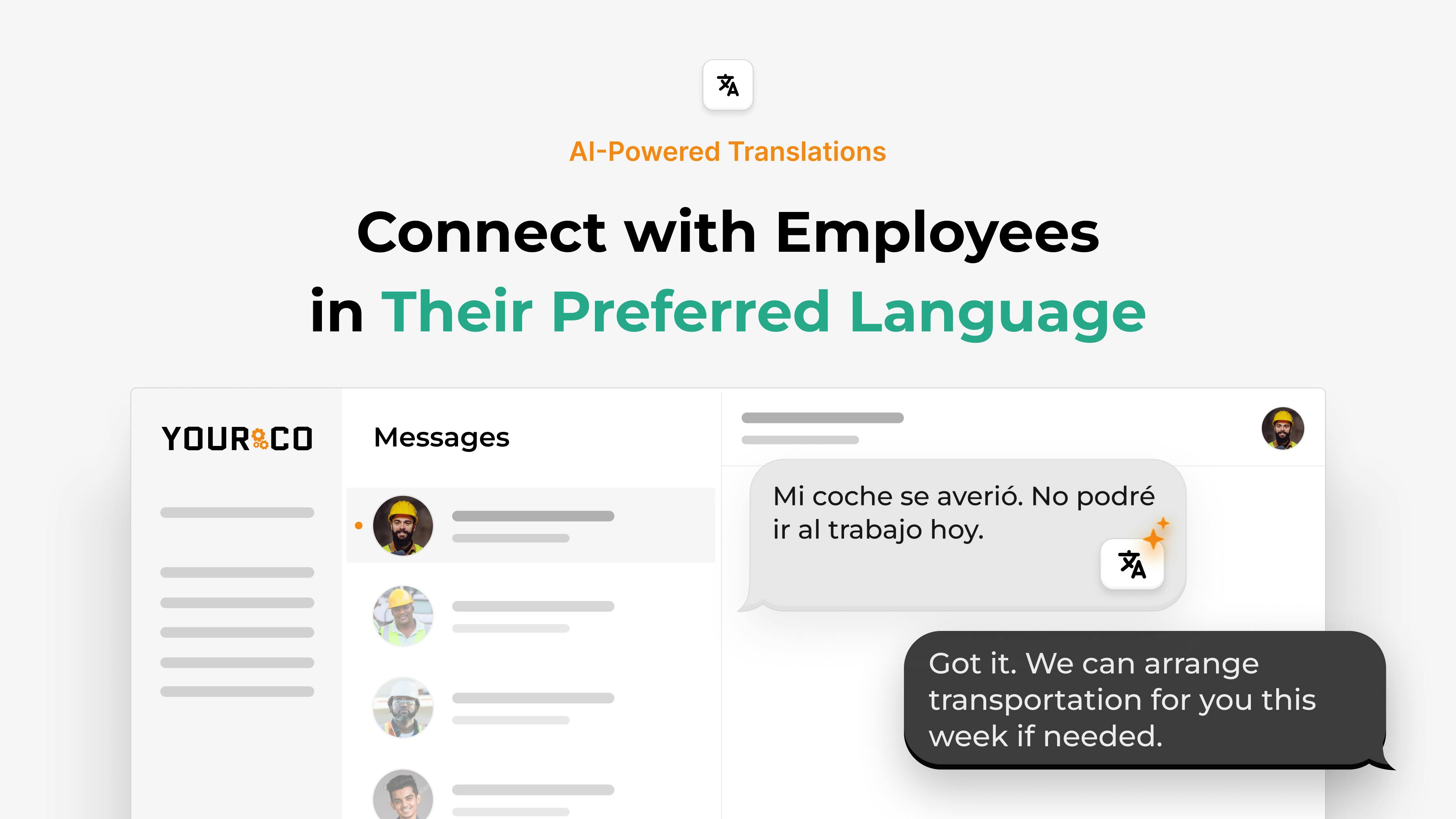How to Onboard Chinese-Speaking Employees in 9 Simple Steps


During onboarding, clear communication is the bedrock of safety and engagement for your Chinese-speaking employees. Only about 3-5% of China's population speaks English fluently, and even fewer feel confident using it at work. This leaves most new hires deciphering critical information in a second language.
When language barriers slip through the cracks, the costs can add up quickly. A mislabeled lock-out tag can halt a production line. A misunderstood scaffold instruction leads to injuries and workers' compensation claims. Additionally, non-native speakers may sometimes feel overlooked during onboarding due to language barriers, which can drain their motivation before they even settle into their roles.
You've likely seen the fallout yourself: confused questions about PPE, unsigned HR forms, or silent nods that mask uncertainty. The good news is that these barriers are preventable. This guide provides nine steps to help you remove translation roadblocks, boost early engagement, and ensure every new hire hits the ground running, regardless of their dialect.
1. Audit & Translate Essential Materials Before Day One
Before your new Chinese-speaking employee walks through the door, every document they'll encounter needs to be in their native language. This simple step prevents costly mistakes and shows respect from day one.
Gather every document a new hire will see:
- Offer letters
- Safety manuals and procedures
- The employee handbook
- HR forms
- Compliance paperwork
Translate each one into clear Mandarin and, if your workforce speaks Cantonese or another dialect, provide that version too. Begin with safety protocols and legal acknowledgments, as language gaps in these areas can lead to costly errors and regulatory compliance issues.
For translation, you have two main options:
- A certified human translator: This is the most accurate option, especially for sensitive or legally binding documents, such as offer letters, compliance paperwork, or safety procedures. Human translators ensure cultural nuance and legal clarity, but the service can be costly and time-consuming.
- AI-powered tools: These platforms are ideal for translating internal content such as handbooks, HR forms, or training materials when speed and scalability matter. Most allow instant edits and support dozens of languages, making updates fast and affordable.
It’s best not to rely on a bilingual coworker since informal translations often miss the specialized wording that keeps you compliant. For official use, consider combining AI-generated drafts or casual translations with a formal human review to ensure accuracy.
It’s also a good idea to have a library of materials to support any translations you may need down the line:
- Terminology: Build a glossary for technical terms and job-specific language so that terms like "lockout–tagout" or "fall-arrest harness" are never misinterpreted.
- Visuals: Include graphics and diagrams that can be easily understood without translation.
- Videos: Subtitles and voiceovers should accurately reflect the written translations, allowing employees with limited literacy to follow along.
- Forms: Don’t forget printed forms, fillable PDFs, and other essential documentation. Many government agencies provide these forms free of charge.
This upfront investment saves you rework later and shows respect for the vast population that isn't fluent in English, setting a solid foundation for every step that follows.
2. Use SMS-Based Pre-Boarding to Set Expectations
Moving beyond document preparation, establishing clear communication channels becomes your next priority. Send a brief, well-timed SMS pre-boarding sequence in Mandarin before day one to remove guesswork and show new hires that communication will always be clear and accessible.
Text messages get seen. SMS has a 98% open rate compared to about 20% for email, making it much more likely your instructions will reach new employees.
Start with a simple three-message sequence:
- Welcome – the moment the contract is signed
- First-day logistics – 48 hours before start
- Required documentation – 24 hours before start
SMS supports attachments, so you can add translated maps, a photo of the entrance gate, or a graphic showing acceptable PPE. Visual aids bridge literacy gaps and save you from writing long explanations.
With Yourco, you can upload these assets directly to the dashboard and send them alongside your text. The platform supports over 135 languages, and Mandarin characters generally display correctly on modern phones that support Unicode. Some other messaging apps or carriers may require extra steps or may not render certain characters perfectly.
Here's a template you can save and reuse again in Yourco's dashboard:
短信 1 – 欢迎
欢迎加入团队!您的第一天是 3 月 18 日上午 8:00。收到请回复 "OK"。
短信 2 – 报到信息
上班地点:江苏省苏州市工业园区 1 号门。请穿安全鞋,佩戴身份证。点击查看地图 ➔ [链接]
短信 3 – 文件准备
为加快入职,请携带身份证复印件 2 份和银行卡信息。如有疑问,直接回复此短信。
Invite questions in every text and answer promptly. Two-way dialogue eases first-day nerves and signals psychological safety from the start. Schedule sends during waking hours for the employee's time zone, especially if you're operating across provinces.
3. Provide a Bilingual Welcome & Safety Briefing on Day One
With pre-boarding expectations set, day one becomes about following through on your communication commitment. The first day sets the tone for everything that follows, so start with a bilingual orientation that eliminates confusion.
Schedule a live interpreter or find a Mandarin-speaking team member to walk new hires through the agenda, their roles, and key contacts. If you need to use translation technology, project slides in both languages and pause frequently for questions. Misunderstandings about procedures or equipment can lead to workplace accidents.
Move straight into safety training. Show a short video with Simplified/Traditional Chinese subtitles or voice-over, then reinforce the message through hands-on demonstrations:
- Fitting PPE and a safe workstation setup
- Practicing emergency exits
- Operating machinery under supervision
- Reporting procedures for hazards or incidents
Visual learning works across all language barriers and helps employees remember critical safety steps better than written instructions alone.
Before new hires leave the room, it’s a good moment to ensure they’ve completed all paperwork. So keep translated versions ready and collect mobile-friendly digital signatures to avoid stacks of paper.
4. Pair Each Hire with a Mandarin-Speaking Buddy
Building on your structured first-day approach, human connection becomes the next important element. Giving every new hire a trusted Mandarin-speaking buddy transforms unfamiliar hallways and workflows into safe territory from day one. The ideal buddy combines a certain level of seniority with clear communication skills, cultural empathy, and the patience to explain why a process matters, rather than just repeating steps.
For the first 30 days, structure the relationship with daily five-minute check-ins during the opening week, followed by weekly touch-bases for the rest of the month. These short, focused conversations let new employees ask questions in their own language and practice key English phrases without embarrassment or cultural pressure. Cover topics like workstation safety, how to request PPE, when wages are processed, and workplace norms such as giving feedback to supervisors.
Recognize the work onboarding buddies are doing to keep the program healthy. A small bonus or public acknowledgment on payday reminds experienced staff that coaching is valued work, not an extra burden.
Watch for warning signs like buddy burnout or new hires who lean only on their mentor and avoid the wider team. Rotating responsibilities after the first month helps both parties build broader relationships and reinforces that the buddy serves as a bridge between cultures and workplace norms, not a permanent crutch.
5. Set Up Segmented Communication Channels
While buddy relationships provide personal support, systematic communication channels ensure no one gets left out or overlooked. Before you can teach, train, or survey a new hire, you need a communication pipeline they actually understand.
Start by creating segmented lists, such as "Pudong-Night Shift," "Warehouse-Forklift Operators," or "Cantonese Speakers." Segments let you target only the people who need a specific update, keeping everyone else's phones blissfully quiet.
Regular cadence matters as much as content. Daily communications at the same time build trust and help both desk and non-desk workers plan around announcements. A simple rhythm might include a 9 a.m. shift-start reminder, followed by a mid-shift safety tip with photo or diagram, and ending with a brief two-question pulse check. This consistent pattern keeps your crew informed without overwhelming their phones.
Of course, not every message should invite conversation. So unlike many employee communication apps that blur urgent and routine messages, Yourco lets you toggle between one-way alerts and two-way chats.
- One-way broadcasts: Urgent items, such as evacuation orders, power shut-offs, and wage reminders.
- Two-way threads: Questions, suggestions, and safety observations.
When employees know where their voice fits, participation climbs and noise drops.
6. Deliver Job-Specific Training in Preferred Languages
With communication channels established, focus shifts to skill development. Start by breaking every lesson into smaller, five-minute modules you can translate and send by SMS. Short, focused content keeps attention high and makes it easy to attach a Simplified/Traditional Chinese PDF, video, or infographic that opens with a single tap — no app download, no scrolling through long manuals.
Next, blend those digital modules with hands-on demos on the shop floor. Show the task once, then hand out a laminated job aid in Chinese so new hires can reference it while they practice. This "watch, read, do" rhythm prevents reliance on memory and lowers the risk of dangerous shortcuts. When jargon is unavoidable (e.g., torque specs or chemical names), use an AI translator that supports custom glossaries to lock in consistent wording across all materials.
Always close the loop on comprehension. A three-question quiz after each module, or a quick photo of the completed task sent back via SMS, lets you confirm understanding without pulling workers off the line. Misunderstandings usually decrease when workers aren't left to decode unfamiliar language or idioms they've never encountered in the break room.
7. Reinforce Cultural Integration & Team Building
Beyond skill acquisition, cultural integration determines long-term success. Help new Mandarin-speaking teammates feel at home in a culture that may prize hierarchy, harmony, and guanxi (relationship-building) over the direct, individual-focused style many U.S. firms use. When you get cultural integration right, you unlock deeper engagement, faster collaboration, and fewer misunderstandings.
- Host Bilingual Team Events: Host a welcoming event within the first two weeks, using both English and Chinese, to break the ice and explain U.S. workplace norms.
- Create Safe Communication Channels: Adjust your feedback style to accommodate indirect Chinese communication, encouraging questions and providing anonymous channels for concerns.
- Make Inclusion Ongoing: Integrate inclusion into everyday routines by rotating project leadership, involving Chinese-speaking employees in daily communications, and celebrating cultural holidays and contributions.
- Train Everyone on Cross-Cultural Awareness: Provide ongoing cultural sensitivity training for the entire team to help English-speaking colleagues understand concepts like collectivism and face-saving, fostering smoother integration and higher engagement.
8. Track Progress with Surveys & Check-Ins (30/60/90 Days)
ultural integration requires ongoing measurement to ensure effectiveness. The quickest way to spot problems early is to ask new hires how they feel, often and in their own language. You can send a five-question SMS survey through Yourco at the end of the first week. A simple yes/no or 1-to-5 scale lets workers answer in seconds, even on a factory floor. Typical prompts include:
- "How safe do you feel doing your tasks?"
- "Do you have the tools you need?"
- "Do you feel welcomed by your team?"
- “Is it clear who to go to when you have a question or concern?”
- “Do you understand the workplace rules and expectations?”
Yourco's analytics let you view results by language group, so you can see if Mandarin speakers are struggling while English speakers thrive. Set an alert when any score dips below 4/5. That triggers a call with the supervisor and, if needed, a fresh translation of confusing materials.
Pair surveys with structured check-ins at 30, 60, and 90 days. Review employee survey feedback at these milestones to spot trends early and respond before small issues snowball.
- Day 30: Focus on role clarity and safety
- Day 60: Dig into cultural integration and peer relationships.
- Day 90: Review skill mastery and career goals.
Use open-ended questions, listen without judgment, and reassure employees that honest answers will never hurt their wages or standing. When workers feel psychologically safe, they are more likely to surface issues before they become accidents or resignations.
9. Evaluate & Optimize Your Program
Continuous improvement ensures your program stays effective as your workforce evolves. Successful programs track four key metrics:
- Retention
- Safety
- Time-to-productivity
- Engagement
Schedule quarterly health checks to review program effectiveness. Audit translated documents for accuracy, observe training sessions to confirm terminology still resonates, and analyze quiz results to identify knowledge gaps. When completion rates drop, check translation quality first, as employees often disengage when the wording feels unclear.
For an additional check, capture human feedback through your buddy system. Ask buddies for brief voice notes after week four based on these kinds of questions:
- ‘’What questions keep coming up?’’
- ‘’Which job aids need clearer visuals?’’
Feed these insights back into your material library, replace outdated PDFs, and record fresh voice-over translations when needed.
Keep your program adaptable. Workforce demographics shift, regulations change, and regional dialects emerge over time. Combine hard metrics with regular input to refine the process continuously. This approach ensures every new hire starts safe, confident, and ready to
Create a Workplace Where Every Employee Can Thrive
Yourco stands out as an ideal solution for effectively implementing many of these steps, such as providing robust SMS communication tools for pre-boarding, hosting bilingual safety briefings, and tracking progress with surveys and check-ins. These features ensure clear, two-way communication with deskless workers who may not have regular access to digital tools, promoting seamless information flow and increased engagement.
With Yourco, you can simplify translations in over 135 languages and streamline processes, ensuring your program is inclusive and culturally sensitive. This will empower Chinese-speaking employees and create a workplace where everyone can thrive, irrespective of their language.
Try Yourco for free today or schedule a demo and see the difference the right workplace communication solution can make in your company.
Frequently Asked Questions
How many languages can Yourco translate automatically?
Yourco's AI engine supports 135+ languages, including Traditional Chinese and Simplified Chinese.
How often should I send routine updates?
Most teams succeed with one morning broadcast, a mid-shift safety note, and an end-of-day feedback prompt — enough to stay connected without flooding phones.
Why do I need to cover U.S. workplace norms if my materials are already translated?
Language access ensures comprehension, but cultural cues — like how PTO is requested or how openly to challenge ideas — still differ. Explaining the "why" behind each norm prevents silent confusion and builds trust.
How soon should I schedule cultural-sensitivity training?
Hold the first session within the new hire's first month so habits form early. Follow up every quarter to reinforce concepts and include examples that surfaced on the floor.
What if my Mandarin-speaking employees are reluctant to speak up?
Pair each person with a trusted buddy, solicit anonymous feedback via SMS surveys, and offer one-on-one check-ins with supervisors trained to ask open, face-preserving questions. Over time, these layers create psychological safety that encourages honest dialogue.
Why are new hires still struggling after we translated the handbook?
Translations that ignore local dialects or industry terms cause gaps. Test comprehension with quick quizzes and update glossaries for regional language, then re-issue a simplified version.
How can I tell if auto-translation tools are failing?
Look for patterns, such as repeated clarifying questions and stalled form completion. When these spike, run side-by-side human reviews of key passages and correct mistranslations immediately.
What's the best way to revive a stalled feedback loop?
Switch to ultra-short SMS surveys in Mandarin, limit each to five emoji-based questions, and promise fast follow-up. Response rates increase when workers see that their comments result in visible changes.



